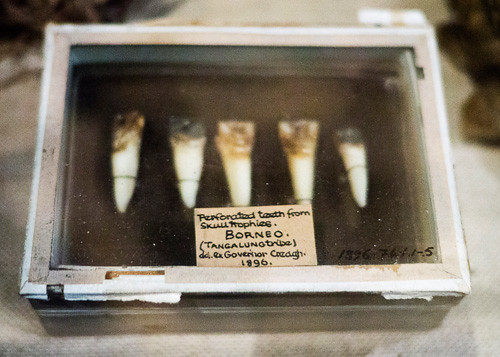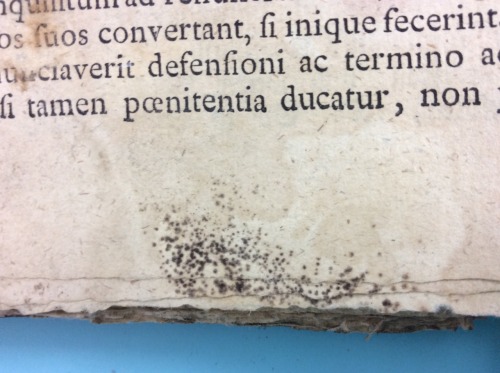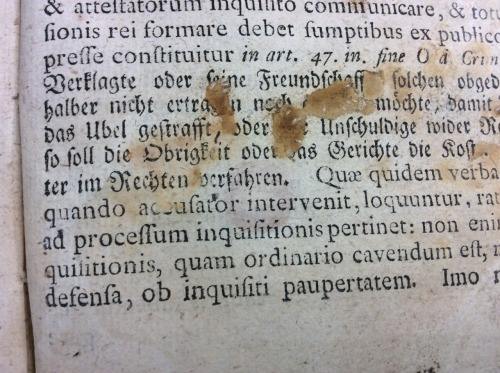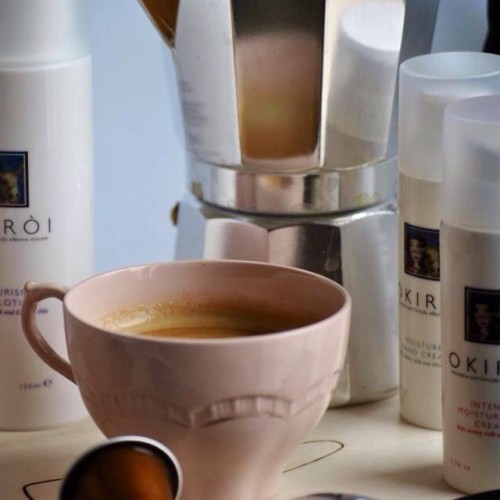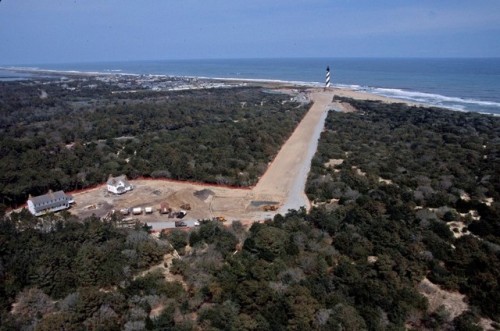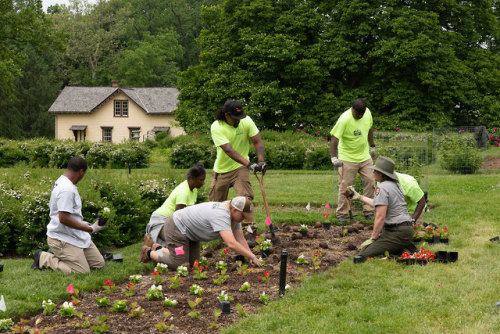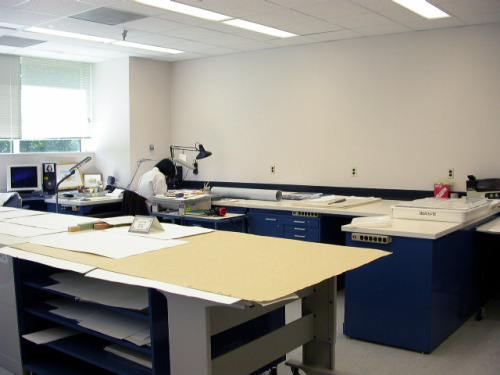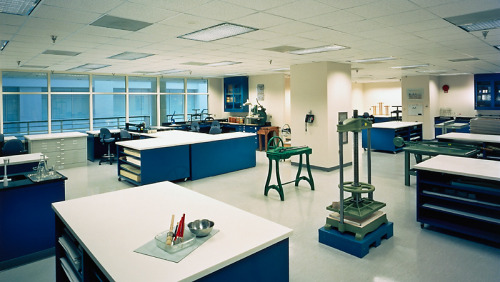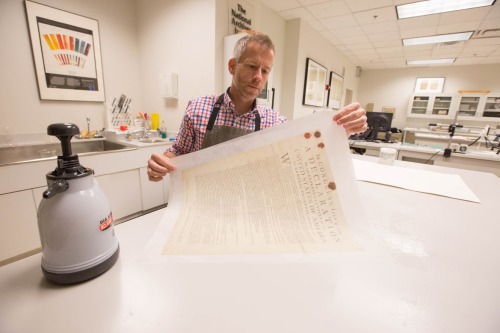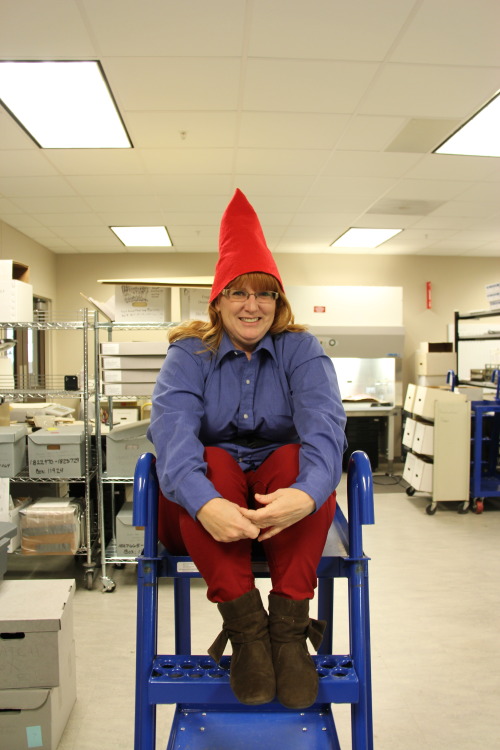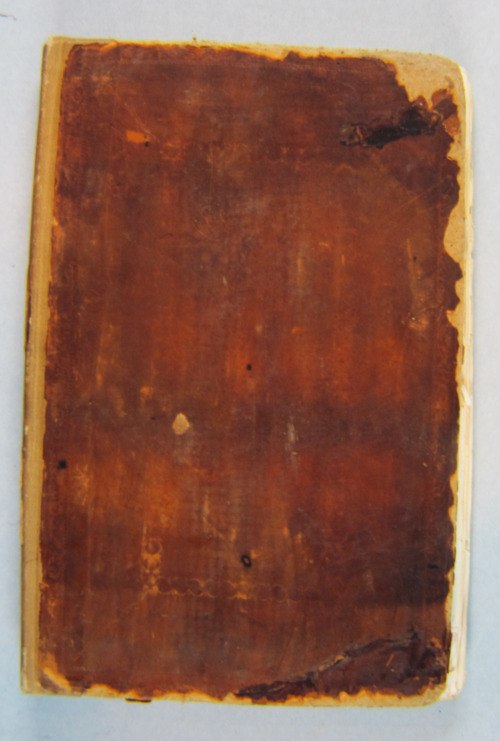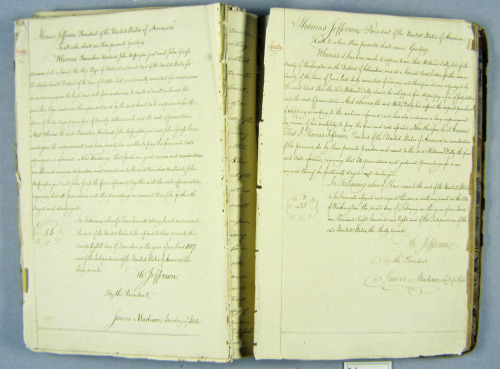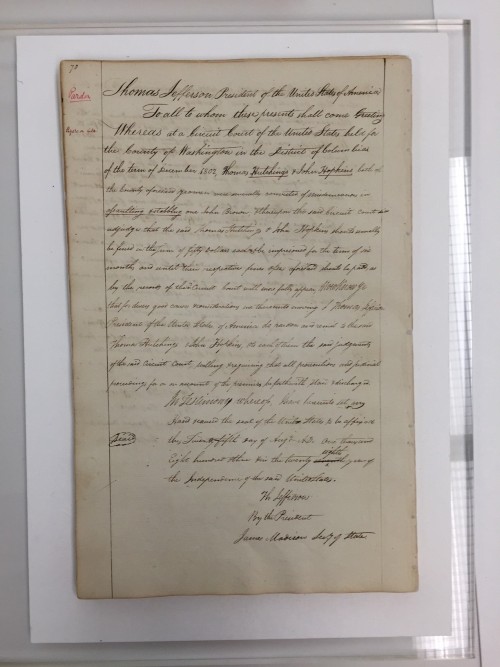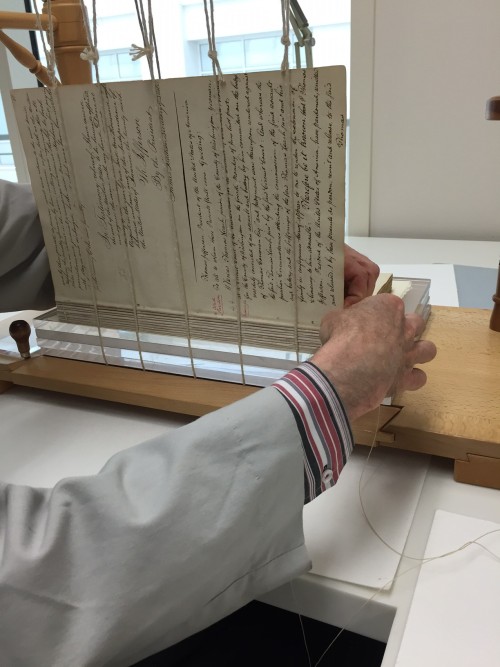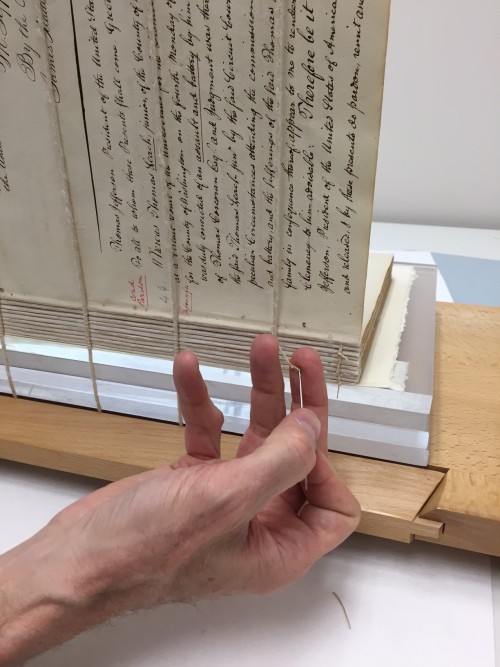#preservation
by Michael Grant
This week we published a piece on our special collections blog, The Back Table, detailing our work on a collection of hundreds of short actuality films of New York City c. 1952. Shot in stunning black and white by Richard Leacock for an NYU promotional film (titled simply New York University) by Willard Van Dyke, the films present surprising, candid, often delightful views of the city at mid-century.
Read more about the project, and enjoy some of the films below!
These films are part of the George Amberg and Robert Gessner Papers (MC.199), held by NYU Special Collections.
“Spaghetti Joint” (MC.199, ref642-198)
“Polish & Sweep” (MC.199, ref578 & ref680-313)
Pedestrians crossing the street (MC.199, ref563-081)
Traffic on FDR Drive (MC.199, ref661)
Corpse Bride by Joshua Hoffine (https://joshuahoffine.wordpress.com/2012/12/13/corpse-bride/amp/)
Post link
This poor book was full of mold, dirt, and accretions. (I urge you to click on the first image so that you can see a larger version). The mold was inactive when it came down to the lab, but the dark, black, fuzzy stuff still made me shudder.
I vacuumed the entire book - page by page - in the fume hood, using a vacuum with a HEPA filter, and wearing personal protective clothing. It took about 3 hours to vacuum the entire book.
Even inactive mold can produce allergic symptoms in sensitive individuals, and we wouldn’t want our patrons to become sick while using our collections! Although the mold spores have been removed, some staining remains. Additional conservation is needed to make this book usable, since the sewing is broken, the pages are loose, and the binding is badly distorted. Just another item for my “to do” list!
-Bexx
Yuck! These are the kinds of copy-specific features we don’t want to preserve for posterity. The staining, at least, tells a story—but the presence of the mold itself (active or inactive) is obviously a serious health risk.
For more on moldy books and what to do with them, check out these other fantastic posts from our Library’s Wallace Conservation Lab Tumblr:
Mold, certain adhesives, and some pigments fluoresce under UV light
Mold from a July 4th, 2015 water leak (extra disgusting)
Purple paper staining the result of extensive mold damage
Vacuuming moldy books in the conservation lab (gif)
A big thank you to all the conservators out there for the work you do—behind the scenes—keeping patrons and staff safe and ensuring our library books are usable for generations to come!
~Andrew
Post link
We are getting excited for the @ohassociation conference sponsored by @sworalhistory in Salt Lake City October 16-20! Our oral history collections are growing and we look forward to sharing our research with these networks.
#archive #preserve #exhibit #70degrees #archives #preservation #Exhibition #Exhibition #oralhistory #history #historians #southwest #CA #California #narrative #story #Rode #Canon #audio #equipment
https://www.instagram.com/p/B3bBv6dJHlb/?igshid=1q5c6m3v96tpg
Post link
Ronald Reagan Presidential Library and Museum has an impressive site. Instead of a typical orientation film, you will be inpressed by the museum’s Reagan #hologram. We viewed the ranch narrative. “The Tack Room at Rancho del Cielo – President #Reagan has just returned from a #horseback ride and he talks to us about the Ranch and how it helps him to balance the pressures of the Oval Office, and then tells us a little about his ideas on #freedom.”
While you visit, be sure to visit the archive. #October is the designated month for American archives. “As a Presidential Library administered by the National Archives and Records Administration (#NARA), the Reagan Library, under the authority of the Presidential Records Act, is the repository of presidential records for President Reagan’s administration. The Library’s holdings include over 60 million pages of documents, over 1.6 million #photographs, a half million feet of motion picture #film, tens of thousands of audio and video tape, and over 40,000 #artifacts.”
The are located at 40 Presidential Drive |Simi Valley, CA 93065. The are open hours are 10 a.m. – 5 p.m. seven days a week.
#archive #preserve #exhibit #70degrees #archives #preservation #exhibition #CA #history #historians #southwest #RonaldReagan #nationalarchives #USA (at Ronald Reagan Presidential Library)
https://www.instagram.com/p/B3MznO5pYBy/?igshid=16wut33azo8tb
Post link
Located in the heart of the Los Rios District, the San Juan Capistrano Historical Society has been restoring and preserving historical structures. It is adjacent to the Capistrano Depot that actively takes you on the #train throughout #SoCal.
The National Trust for Preservation established the week long tradition of recognizing preservation practices during the Nixon administration. They now show how #ThisPlaceMatters with a toolkit for grassroots organization. We celebrate all the month of May. The trust created a list of 31 actions, one for each day, for you to get active in this movement. Visit https://savingplac.es/2VYOlr6 via @savingplaces.
#70degrees #tbt #history #fieldnotes #fieldnote #fieldwork #historian #preserve #preservation #story #stories #narrative #structure #building #restore #save #archive #SanJuanCapistrano #SJC #SanJuan #district #historicdistric #CA #California (at Los Rios District)
https://www.instagram.com/p/Bxz4vPtn3ba/?igshid=m6ze9t7jbfrs
Post link
Βροχερή ημέρα, ενδείκνυται για ζεστό καφέ και ενημέρωση!
Το γάλα γαιδούρας περιέχει βιταμίνες Α1, Β1, Β2, C και Ε καθώς και ένα εξαιρετικό ποσοστό ανοσοσφαιρήνης, μαγνήσιο, ασβέστιο, κάλιο, φώσφορο, ψευδάργυρο και sodium.
Οι πρωτεΐνες γάλακτος προσφέρουν αξιόλογες ενυδατικές και θρεπτικές ιδιότητες, ως αποτέλεσμα της εξαιρετικής απορρόφησής τους από την επιδερμίδα, καθώς και της δυνατότητας τους να δεσμεύουν νερό. Παράλληλα απελευθερώνουν συγκεκριμένα αμινοξέα, τα οποία είναι πολύ σημαντικά συστατικά του φυσιολογικού ενυδατικού παράγοντα του δέρματος (ΝΜF) και της διατήρησης της φυσιολογικής μεταβολικής δραστηριότητας των κυττάρων, καθώς συμμετέχουν στη σύνθεση του κολλαγόνου, της ελαστίνης και της κερατίνης. Όλα αυτά τα χαρακτηριστικά προάγουν τη δημιουργία ενός υγροσκοπικού φιλμ στην κεράτινη στοιβάδα της επιδερμίδας.
#Rainy #day, indicated for hot #coffee and #update!
#Donkey #milk contains #vitamins A1, B1, B2, C and E and an #excellent rate of #immunoglobulins, #magnesium, #calcium, #potassium, #phosphorus, #zinc and #sodium.
The milk #proteins offer #remarkable #hydrating and #nutritional #properties, as a #result of their excellent #absorption into the #skin, and the #ability to #bind #water. Furthermore, they release specific #amino #acids, which are very #important #components of the #normal skin #moisturizing #factor (NMF) and of #preservation of the normal #metabolic #activity of #cells, as they are involved in the #synthesis of #collagen, #elastin and #keratin. All these #characteristics #promote the #creation of a #hydroscopic #film on the #stratum #corneum of our skin.
Post link
Long before today’s CGI special effects, early animators of the silent era experimented and introduced new techniques into filmmaking. Check out a tour of the silent animation collection at the UCLA Film & Television Archive—one of the few places in the world that captures this rich history of early animation.
A Landscape of Change: Cape Hatteras Light Station
Twenty years ago, in the summer of 1999, the Cape Hatteras Light Station was moved 2,900 feet from the spot where it had stood since 1870.
As the natural process of shoreline erosion transformed this dynamic coastal environment, the tallest brick lighthouse in the United States now stood dangerously close to the ocean’s edge.
The remarkable undertaking including efforts to protect the structures, maintain the coastal setting of the original site, and preserve the original orientation to the shoreline and spatial arrangement of historic structures in the landscape.
Discover more about the transformation and preservation of this cultural landscape: Landscapes of Change: Cape Hatteras Lighthouse
- Photo album of the 1999 Cape Hatteras Light Station move
- Cape Hatteras Light Station Cultural Landscape Report
- Cape Hatteras Light Station Cultural Landscape Inventory
- Cape Hatteras National Seashore website
- More about cultural landscapes
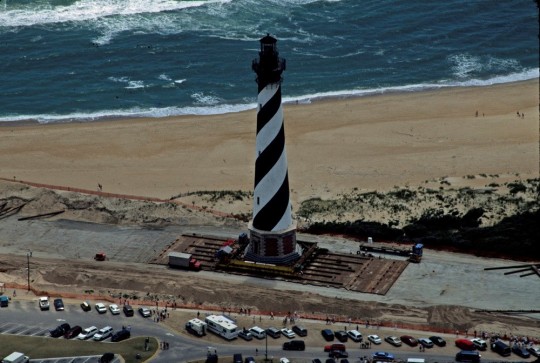
Driving the lighthouse along the beach to its new location on June 24, 1999 (NPS).
Post link
Parterre Planting
In 2010, the Falling Gardens at Hampton National Historic Site were rehabilitated to reflect their historic configuration. The six parterres that comprise the Falling Gardens were re-defined on the turf-carpeted terraces and replanted to represent circa-1867 planting schemes.
The garden rehabilitation helped evoke the grandeur of the historic landscape, which had fallen into disrepair by the mid-1900s with missing and overgrown vegetation.
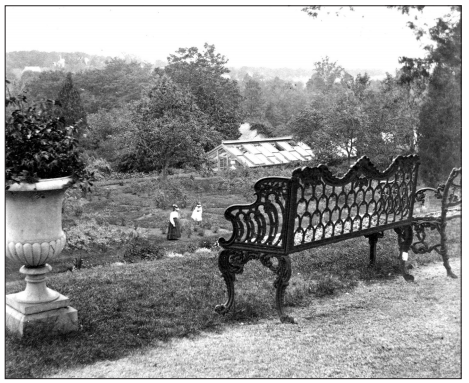
The Falling Gardens and Greenhouse #2 from the Great Terrace, looking southwest, 1872 (NPS/HAMP 3493, in Cultural Landscape Report).
The work didn’t end there, however.
Annuals are planted in the parterres each spring. This year, park staff, a summer work crew of 6 people, and volunteers planted 3,398 plants over a 2-week time period.
Want to see more of the 2019 parterre planting at Hampton National Historic Site?
(Recorded by and shared with permission of Tim Ervin, via Flickr.)

How do Cultural Landscape Reports inform landscape preservation?
Discover history, plant lists, before and after photos of the Falling Gardens, and more about Hampton National Historic Site cultural landscape :
- Cultural Landscape Report, Volume I (Site History, Existing Conditions, Analysis and Evaluation)
- Cultural Landscape Report, Volume II (Treatment and Record of Treatment)

The Falling Gardens and Greenhouse #2, c. 1935 (NPS/HAMP 19240, in Cultural Landscape Report).
Post link
Cultural Landscape Preservation
It’s already the end of May, which means that Preservation Month is coming to a close. Here are just a few ways to continue exploring cultural landscape preservation in the National Park Service:
You can also find access to the Integrated Resource Management Applications (IRMA) Portal there, an NPS-wide repository for documents, publications, and data sets related to natural and cultural resources of the National Park Service. The cultural landscape documents in this growing collection contain history, analysis, and treatment recommendations to support the management of cultural landscapes.
These videos highlight preservation projects in various park cultural landscapes, revealing how management documents (like Cultural Landscape Reports) guide preservation treatment that can impact the experience of historic places.
Keep celebrating preservation all year!
Post link
Appomattox Court House Village, April 9
On April 9, 1865, the surrender of the Army of Northern Virginia in the village of Appomattox Court House, Virginia signaled the end of the Civil War. The landscape at Appomattox Court House National Historical Park marks the beginning of the country’s transition to peace and reunification following four years of war. The rural landscape is also significant in areas of architecture and conservation.
In commemoration of the 154th Anniversary of Lee’s surrender to Grant, learn more about the park’s cultural landscape through a new video and the recently published Cultural Landscape Report:
- Discover the Appomattox Court House Village landscape through the latest video from the Olmsted Center for Landscape Preservation
- TheCultural Landscape Report Treatment Implementation Plan guides long-term management and preservation decisions for this historically significant landscape.
- Visit the Appomattox Court House National Historical Park website to learn more and plan your visit
- More information about the Appomattox Court House Landscape

Thereconstructed McLean House at Appomattox Court House, the site of the surrender on April 9, 1865 (NPS Photo).
The Brain Scoop:
Conserving Akeley’s Elephants
It’s been about 3.5 years (!) since we’ve talked about Carl Akeley’s fighting African elephants (throw back to that first video here– I was such a baby science communicator!!!). These elephants represent some of the best taxidermy ever created, but after being on display for the last century they’re beginning to show their age.
So, the Field hired a team of conservators to assess the specimens, with the hope of repairing damage sometime this year, so they can continue to inspire and educate our visitors for another 100 years.
Conservator Technician (GS-7) at the US NATIONAL ARCHIVES
The National Archives and Records Administration (Washington DC area) is seeking applicants for the position of Conservator Technician GS-7. This is a permanent full time position that will focus on carrying out basic conservation treatments and preventive conservation activities on archival records. The salary range is $43,684.00 to $56,790.00 / per year.
Applications are due at the end of this week on Friday, December 9.
Please see the link to USAJOBS for more information about the position and application process:
https://www.usajobs.gov/GetJob/ViewDetails/449618900
Post link
Two staff members from the Preservation program in St. Louis experienced quite a case of déjà vu last month. The staff were set to present at a statewide museums and archives conference in St. Joseph, Missouri about the preservation work being done on burned military records from the 1973 NPRC-St. Louis fire.
The night before the staff were set to speak, a fire broke out in an older building a block north of their hotel. (See photo) Visitors in the hotel were evacuated, as embers from the fire were floating northward and managed to set another building’s roof on fire. Nobody was hurt thanks to the quick response of the fire department, but it was definitely a tense situation! Nobody knows better than the Preservation Program at St. Louis about the devastation that fire can wreak on buildings and the items within those buildings. As our staff works every day to preserve the records of the past, it is our hope that no other archive or museum has to experience such a destructive event. Our hearts go out to those in Tennessee and elsewhere who have been effected by the recent wildfires.
Post link
NARA’s copy of the first printing of the Declaration of Independence, more commonly known as the “Dunlap Broadside” underwent extensive conservation treatment this past summer. The document, printed in Philadelphia the afternoon or evening of July 4, 1776 by John Dunlap, was originally tipped into the Rough Journal of the Continental Congress and had been extensively repaired over its lifetime. A NARA conservator carefully removed a fabric lining that was probably done in the early 20th century, followed by washing with buffered deionized water on a suction table to reduce discoloration and acidity. Remaining treatment steps included filling losses in the paper with a cotton/linen paper pulp followed by lining with two sheets of very thin Japanese mulberry tissue.
[RG 360, Paper of the Continental and Confederation Congresses and the Constitutional Convention]
Post link
Happy (belated) Halloween!
Look what we found on Halloween in the Decontamination Lab at our Preservation program in St. Louis! After changing her title from Preservation Technician to Preservation Gnome, Shannon got down to business surface cleaning burned records from the 1973 fire. Gno-matter what, preserving records comes first! Shannon has been working at NARA-St. Louis for almost 8 years, and her background is in repairing, filming, and preserving microfilm. We love having her on the team, and she is definitely our favorite gnome by far!
Post link
In St. Louis, the demand for military personnel records is high. Preservation Technicians prepare thousands of record pages annually in preparation for reformatting. In addition, Preservation Technicians review about 50,000 records damaged in the 1973 fire. All records have some level of damage, and our staff cannot fully treat every record. As a result, we have a triage based approach that emphasizes holdings maintenance. One of the simple actions we take is relaxing creases on pages in our records.
Each time paper is creased, fibers break. Likely, you’ve seen this happen on pages in a book that have been “dog-eared” to mark a page. If folded back against the crease, more fibers are damaged, until finally there is an entire break along the crease creating a separated fragment. Since we don’t want to crease in the opposite direction, staff always keep a bone folder handy while reviewing and working with records. This handy tool, which, as its name implies, was actually developed to create strong creases in bookbinding and other crafts. However, the bone folder also works well to relax the paper fibers. Creases are gently opened on a flat surface. With the peak of the crease facing upwards, the bone folder is used to gently rub along the crease to flatten paper fibers, as seen in the pictures here. This is repeated as necessary when a document has multiple creases. This simple treatment allows documents to lie completely flat and secure in their folders and prevents fragmentation and tearing of the documents while in reference use.





TIME SENSITIVE
GS-13 Conservator (Digitization) Vacancy at US National Archives
The US National Archives is seeking a Digitization Conservator (GS-13) to serve as the technical expert in the preservation requirements for the digitization of its archival materials. The Digitization Conservator will coordinate National Archives digitization conservation activities, examine and treat National Archives collections, conduct training and make recommendations for digitization policies, guidance, programs and procedures. The position will be based in College Park, MD. Salary range: $92,145 to $119,794 per year.
Applications are due by 11/7/16. For additional information and specific application information see: https://www.usajobs.gov/GetJob/ViewDetails/448491500/ for US citizens (Job Announcement JD1784356TBD) and https://www.usajobs.gov/GetJob/ViewDetails/448380100/ for status candidates (Job Announcement JD1783183TBMP).
TIME SENSITIVE
GS-13 Conservator (Exhibits) Vacancy at US National Archives
The US National Archives is seeking an Exhibits Conservator (GS-13) to serve as the technical expert in the preservation requirements for the exhibition of its archival materials. The Exhibits Conservator will coordinate National Archives exhibits conservation activities, examine and treat National Archives collections, conduct training and make recommendations for exhibit policies, guidance, programs and procedures. The position will be based in Washington, DC. Salary range: $92,145 to $119,794 per year.
Applications are due by 11/7/16. For additional information and specific application information see: https://www.usajobs.gov/GetJob/ViewDetails/449339600/ for US citizens (Job Announcement JD1791936TBD) and https://www.usajobs.gov/GetJob/ViewDetails/449160700/ for status candidates (Job Announcement JD1790288TBMP).
First Volume of Presidential Pardons
This volume contains early copies of pardons granted by the first five presidents of the United States. The original leather binding was very tight, severely red rotted, and the spine had been poorly mended with cloth. The textblock was split and pages were torn. Book conservator Steven Loew mended the pages, rejoined all split folios and guarded weak center folds (mended all along), resewed the entire textblock on five linen cords, and bound it into a new cloth cover with a flexible spine that reveals the sewing cords. This record book can now be safely accessed. The images show the original binding, the spine and the split textblock before treatment, a repaired section of pages ready to be sewn, the text block being sewn, and the volume in its new cloth cover with a flexible spine that reveals the sewing cords.
RG 59, entry 897, Pardons and Remissions, Vol. 1 of 16, April 25, 1793 to Nov. 19, 1812
Post link
Give Way to Tanks!
This poster from the WWII foreign poster holdings in the Still Pictures Branch at NARA came to the conservation lab recently for treatment. The poster was humidified and flattened, and the surface was lightly cleaned using vinyl eraser crumbs, which can pick up surface dirt yet are gentle on the paper and media. The cracked and flaking ink was consolidated. Tears were mended and the small loss at the top right corner was filled with acrylic-toned Japanese paper.
[RG 44, Records of the Office of Government Reports, 44-PF-123]
Post link
Iron Age arrow found on Norway mountain still has feather fletching on it
“"I think it is perhaps just the Ötzi-find which has preserved fletching on arrows, but his arrow fletchings are nowhere as well preserved as some of ours,” Lars Pilø, an archaeologist at the Department of Cultural Heritage, Innlandet County Council, Norway, co-director of the Glacier Archaeology Program, told Live Science in an email.
However, “his are older too, by several thousand years, so this is not to diss Ötzi’s arrows,” Pilø said"




